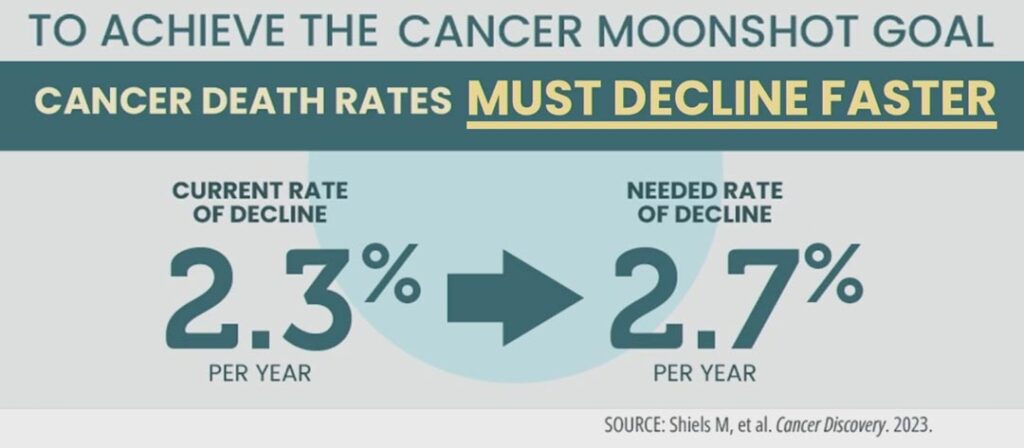
In February 2022, US President Joe Biden announced the return of the Cancer Moonshot initiative, which he first championed during his previous stint as vice president. Central to the Cancer Moonshot: Reducing the cancer death rate by at least 50% by 2047.
Shortly after the resurrection of the initiative, a team from the US National Cancer Institute’s Division of Cancer Epidemiology and Genetics was tasked with answering the question of how to reach that goal. The team, led by Senior Investigator Meredith Shiels, PhD, MHS, recently published their findings in Cancer Discovery.1 Dr. Shiels presented the highlights from the research on April 17 during the 2023 American Association for Cancer Research Annual Meeting.
“The aim of our paper was to assess whether we are on track to reach this goal based on recent cancer mortality trends,” Dr. Shiels said during her presentation. “We did this by estimating cancer death rates and what they could be in 2047 if current patterns continue into the future.”
The team focused on the six leading causes of cancer death in the US and highlighted the most “promising and realistic opportunities to accelerate progress,” she said.
“I would like to emphasize that the NCI is committed to addressing all cancers in all people,” Dr. Shiels said. “This particular analysis focused on those six leading causes of cancer death because addressing these causes is critical to achieving the 50% decline outlined in the goal. But we also want to emphasize that less common cancers including childhood cancers must continue to be studied, and progress must be made.”
The six leading causes of cancer death in the US in the year 2019 were lung, colorectal, pancreas, breast, prostate, and liver. (see Fig. 1)

“Together these cancers caused 57% of the 600,000 cancer deaths that occurred in the year 2019 and progress against these types is really required to meet the Cancer Moonshot goal,” she said.
Using death certificate data from the US Centers for Disease Control and Prevention (CDC), the team determined the age-standardized cancer mortality rate between the year 2000 and 2019.
According to the authors, the data show the tremendous progress during this time thanks to investments in cancer prevention, early detection, and treatment. Dr. Shiels pointed out that the rate of decline in cancer deaths accelerated more between 2016 and 2019 to 2.3% per year.

“If this progress continues at the same rate between 2022 and 2047, we project a 44% further decline in cancer death rates,” Dr. Shiels said. “This would be a tremendous amount of progress over this time. But it would fall short of the 50% decline goal as outlined in the Cancer Moonshot. So cancer death rates must decline faster to reach this goal. We need to get to an average annual decline of 2.7% per year to reach the 50% goal.”
The authors identified opportunities to accelerate progress and to achieve an annual average rate of decline of 2.7%. Specifically, Dr. Shiels said the analysis focuses on continued reductions in cigarette smoking, increased access to and use of early detection and treatments known to work, and investment in ongoing drug discovery.
References
- 1. Shiels MS, Lipkowitz S, Campos NG, et al. Opportunities for Achieving the Cancer Moonshot Goal of a 50% Reduction in Cancer Mortality by 2047 [published online ahead of print, 2023 Apr 17]. Cancer Discov. 2023;OF1-OF16. doi:10.1158/2159-8290.CD-23-0208





